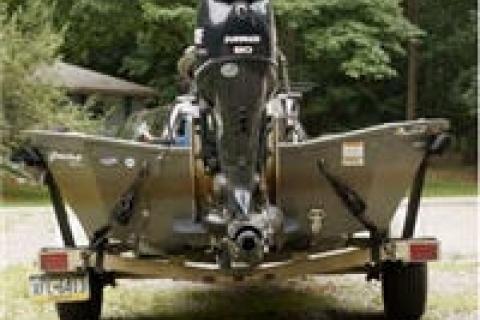
|
Jet boats can go where many standard boats can't, opening up miles of undistrubed areas. |
Shallow-draft boats driven by a jet stream of water can propel an angler to portions of free-flowing rivers that see a comparatively light fishing pressure. Standard propeller-driven boats are limited to deeper pools of such rivers. Jet-powered boats can glide across inches-deep shallow riffles, opening up miles of otherwise undisturbed areas.
Jet Unit
Though it's possible to purchase an outboard engine set up as a jet from some manufacturers, most outboards are converted by a local dealer. In the process a mechanic replaces the outboard's lower unit — the part that houses the gearbox, propeller and skeg — with the jet unit, which is essentially a water pump.
Major components housed within the jet unit include the water intake, impeller and nozzle. As its name suggests, the water intake draws in the water from beneath the boat's hull, directing it into the impeller. The impeller, driven by the outboard's driveshaft, spins the water into a high velocity flow. This flow is channeled through the unit's housing and discharged out the back as a high speed jet of water, the force of which pushes the boat. A deflector pivots into place when the operator shifts into reverse, which swaps the direction of the stream's flow allowing the boat to be backed up.
The jet's intake hangs 1 to 2 inches below the boat's hull, providing the clearance needed to glide across the shallows.
Boat Considerations
Though the outboard jet conversion is a relatively simple process, getting set up to run the shallows isn't as simple as high-tailing it to the local marina with your current boat to have the work done. To ensure optimal performance the boat's hull design is a vital aspect.
|
A flat hull allows the jet outdboard to receive a smooth supply of water. |
To work efficiently a jet outboard must be fed a smooth supply of water, something best accomplished with a fairly flat hull. Heavy duty all-welded aluminum jonboats with a slight "V" — 6 to 10 degrees dead rise is ideal — achieve this. The hull provides a solid air-free flow to the outboard — pushing bubbles out to the side — and has enough bite to keep the boat from skating sideways on turns and when hit with a strong crosswind. The small draft of a johnboat is also a benefit, as it allows an angler to float downriver through skinny water when fishing without bumping bottom.
Compared to a riveted boat, a welded hull is less likely to open up if you hit an obstacle while under power. Naturally, hull thickness plays into this as well. A thickness of .100 inch is a good balance of strength and weight, and is adequate on moderate gradient rivers where sand/gravel is the primary bottom composition. Rivers that are particularly nasty to navigate (i.e., expanses of bedrock bottom) often require thicker hulls, stronger aluminum alloys, and/or the addition of synthetic polymer bottoms.
Written by Jeff Knapp for Bass Pro Shops Outdoor Library
- 16803 views



